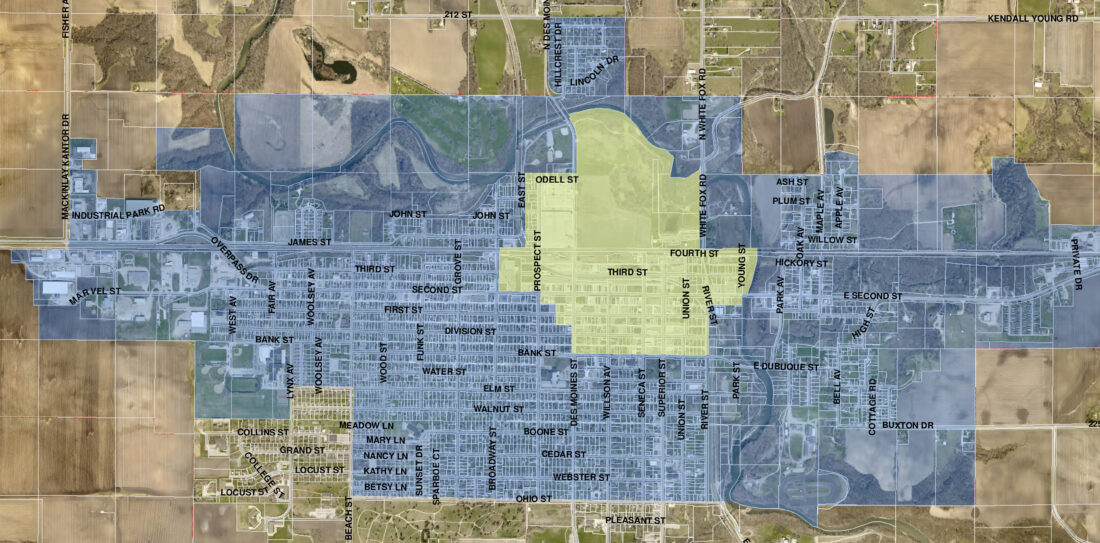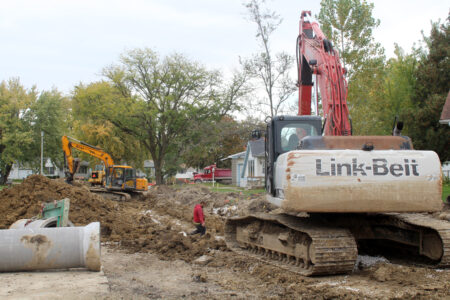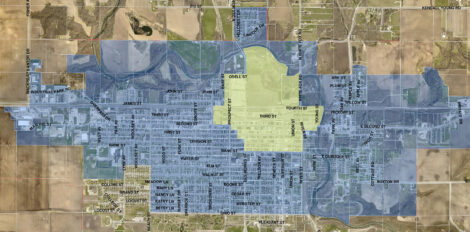Webster City proposes a major TIF district increase

. The green area is a 1986 TIF district. . The blue area is the proposed new TIF district.
The City Council of Webster City took a first step to address failing buildings downtown by unanimously approving a public hearing for a larger urban renewal district Monday.
That bigger district would capture new funds through Tax Increment Financing — TIF — the use of projected higher property tax revenues in future to pay for improvements in a defined geographic area.
The proposal will only be subject to a single public hearing on November 17. This is so details can be completed in time to meet a statewide December 1 deadline for any new TIF financing proposal.
City staff calculated a total of $400,000 may be available in the first year of the new district: $150,000 generated within boundaries of the original district; $150,000 in new funds from the expanded district; and $100,000 in unallocated funds now on hand. It’s a lot of money, but not enough to fix every unstable building downtown.
Three new accounts are being opened to accrue and disperse funds. The first, the nuisance abatement account, will spend up to $150,000 in fiscal 2026 to seek remedies for structures already known to be unsafe or unsightly. Some buildings may ultimately be torn down.
The second account, the downtown revitalization plan, will, similarly, have about $150,000 to spend in fiscal 2026 to stabilize structures in the 400, 500, 600 or 700 blocks of Second Street.
Finally, an urban renewal administration and professional support account will work with private building owners, or the Webster City Area Chamber of Commerce, Hamilton County Growth Partnership, LIFT Webster City or Downtown SMID on downtown revitalization, whatever form that may take.
Speaking of the proposed enlargement of the urban renewal district, City Manager John Harrenstein said, “The objectives of the new district will be very similar to those of the existing district. The new district will benefit from proceeds of the new Kwik-Star development on the west side.”
Urban renewal districts aren’t new in Webster City. Creation of the city’s original urban renewal district was done for reasons whose controversy still echoes today. The city condemned and removed about 45 homes on Odell, Lucas, Merritt and Stockdale streets between the Illinois Central tracks and Riverview School in 1986 to clear land for Webster City Products Co.’s new factory.
Riverview was closed as an elementary school and converted to a day care center adjacent to two enormous parking lots created on land where a neighborhood once stood. Today, one of those former parking lots is still owned by Electrolux; the other is derelict and weed-grown, a potential candidate for nuisance abatement.
Funds from the urban renewal district helped pay homeowners for their property, and for an upgraded and repaved section of Third Street between Des Moines and Superior, to reroute trucks bound to or from the plant around downtown.
Some TIF money also funded downtown streetscaping and, later, a deal that saw Hy-Vee locate its new store downtown.
At the same time the city created the Riverview-Central Business District urban renewal district in 1986, it also set one up in the southeast industrial park. Funds generated within that district paved roads and extended utilities eastward from Iowa Highway 17. The city also built a speculative building available for industrial expansion which remained occupied for many years.
Yet a third urban renewal district was established in the southwestern Webster City, this one to build roads and extend utilities into Brewer Creek Estates for new home construction.





